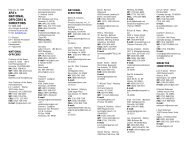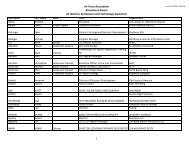The Air Force in the Vietnam War - Air Force Association
The Air Force in the Vietnam War - Air Force Association
The Air Force in the Vietnam War - Air Force Association
You also want an ePaper? Increase the reach of your titles
YUMPU automatically turns print PDFs into web optimized ePapers that Google loves.
Pr<strong>in</strong>cipal US Navy and Mar<strong>in</strong>e Corps <strong>Air</strong>craft<br />
A-4 Skyhawk. <strong>The</strong> s<strong>in</strong>gle-eng<strong>in</strong>e A-4 light<br />
attack bomber was <strong>the</strong> Navy’s primary<br />
light attack aircraft at <strong>the</strong> beg<strong>in</strong>n<strong>in</strong>g of <strong>the</strong><br />
war. It had been designed <strong>in</strong> <strong>the</strong> 1950s<br />
to be light and agile. Unlike most carrier<br />
aircraft, it did not have fold<strong>in</strong>g w<strong>in</strong>gs<br />
because of its short (27 feet, 6 <strong>in</strong>ches)<br />
w<strong>in</strong>gspan. It was also used by <strong>the</strong> Mar<strong>in</strong>e<br />
Corps from land bases. <strong>The</strong> “Scooter” flew<br />
more bomb<strong>in</strong>g missions <strong>in</strong> <strong>Vietnam</strong> than<br />
any o<strong>the</strong>r Navy aircraft. In 1974, a variant<br />
of <strong>the</strong> A-4 replaced <strong>the</strong> F-4 for <strong>the</strong> Navy’s<br />
Blue Angels aerial demonstration team.<br />
A-6 Intruder. <strong>The</strong> tw<strong>in</strong>-eng<strong>in</strong>e A-6 was<br />
an excellent all-wea<strong>the</strong>r bomber. It could<br />
carry more than 15,000 pounds of ordnance.<br />
It has been operational s<strong>in</strong>ce 1963.<br />
It was subsonic but had good range and<br />
accuracy not available from o<strong>the</strong>r aircraft<br />
<strong>in</strong> <strong>the</strong> <strong>the</strong>ater. <strong>The</strong> A-6 was <strong>in</strong>stantly<br />
recognizable by <strong>the</strong> refuel<strong>in</strong>g probe, which<br />
rose like a crank handle <strong>in</strong> front of <strong>the</strong><br />
cockpit. It was crewed by a pilot and a<br />
navigator, seated side by side. It was still<br />
<strong>in</strong> service for Gulf <strong>War</strong> I <strong>in</strong> 1991.<br />
A-7 Corsair. <strong>The</strong> A-7 deployed to <strong>Vietnam</strong><br />
<strong>in</strong> 1967, supposedly to replace <strong>the</strong> A-4 <strong>in</strong><br />
<strong>the</strong> light attack role. Instead, both of <strong>the</strong><br />
aircraft cont<strong>in</strong>ued <strong>in</strong> service for <strong>the</strong> rest of<br />
<strong>the</strong> war. <strong>The</strong> A-7 was modeled on <strong>the</strong> F-8<br />
Crusader (both were Vought aircraft) but<br />
was shorter and had less sweep to <strong>the</strong><br />
w<strong>in</strong>gs. <strong>The</strong> A-7 was also flown by <strong>the</strong> <strong>Air</strong><br />
<strong>Force</strong> late <strong>in</strong> <strong>the</strong> war and stayed <strong>in</strong> service<br />
with <strong>the</strong> Navy until replaced years later by<br />
<strong>the</strong> F/A-18.<br />
F-4 Phantom. <strong>The</strong> F-4 entered service<br />
first with <strong>the</strong> Navy, <strong>the</strong>n with <strong>the</strong> <strong>Air</strong> <strong>Force</strong>.<br />
It was <strong>the</strong> best fighter of <strong>the</strong> <strong>Vietnam</strong> <strong>War</strong>.<br />
All of <strong>the</strong> Navy and <strong>Air</strong> <strong>Force</strong> aces were<br />
<strong>The</strong> MiGs<br />
MiG- . An updated model of <strong>the</strong> Soviet<br />
jet fighter that confronted—and was<br />
bested by—<strong>the</strong> American F-86 Sabre<br />
<strong>in</strong> <strong>the</strong> Korean <strong>War</strong>. <strong>The</strong> MiG-15 was<br />
obsolete and of limited combat value,<br />
but <strong>the</strong> North <strong>Vietnam</strong>ese cont<strong>in</strong>ued to<br />
field it <strong>in</strong> considerable numbers. It was<br />
used mostly for tra<strong>in</strong><strong>in</strong>g.<br />
MiG- 7. Advanced , faster, and more<br />
stable version of <strong>the</strong> MiG-15. Three of<br />
North <strong>Vietnam</strong>’s 16 fighter aces flew<br />
MiG-17s. Especially effective at lower<br />
altitudes, where its 23 mm and 37 mm<br />
cannons could be used to advantage<br />
<strong>in</strong> a turn<strong>in</strong>g fight. <strong>The</strong> MiG-17 defended<br />
North <strong>Vietnam</strong>’s airfields and patrolled<br />
<strong>the</strong> approach and departure routes<br />
used by US aircraft.<br />
A-4 Skyhawk<br />
A-6A Intruder<br />
MiG-21<br />
F-4 pilots. <strong>The</strong> F-4 was also used for <strong>in</strong>terdiction,<br />
reconnaissance, close air support,<br />
and forward air control missions. It rema<strong>in</strong>ed<br />
<strong>in</strong> production until 1979 and flew<br />
with <strong>the</strong> air arms of numerous nations.<br />
F-8 Crusader. <strong>The</strong> F-8 was <strong>the</strong> pr<strong>in</strong>cipal<br />
fighter for <strong>the</strong> Navy and Mar<strong>in</strong>e Corps <strong>in</strong><br />
<strong>the</strong> early part of <strong>the</strong> war. It carried Sidew<strong>in</strong>der<br />
missiles but relied ma<strong>in</strong>ly on its 20<br />
mm cannon, be<strong>in</strong>g <strong>the</strong> last US fighter designed<br />
with guns as <strong>the</strong> primary weapon.<br />
It accounted for 18 MiGs shot down <strong>in</strong><br />
combat and also operated <strong>in</strong> o<strong>the</strong>r roles,<br />
<strong>in</strong>clud<strong>in</strong>g photo reconnaissance.<br />
F-8 Crusader<br />
MiG- 9. Ch<strong>in</strong>ese variant of <strong>the</strong> supersonic<br />
Soviet fighter of <strong>the</strong> late 1950s.<br />
It did not appear <strong>in</strong> <strong>Vietnam</strong> until after<br />
<strong>the</strong> 1968 bomb<strong>in</strong>g halt. It carried two<br />
heat-seek<strong>in</strong>g Atoll missiles (similar to<br />
<strong>the</strong> US AIM-9 Sidew<strong>in</strong>der) but depended<br />
mostly on its three 30 mm guns.<br />
MiG-2 . North <strong>Vietnam</strong>’s best fighter<br />
and a close match <strong>in</strong> capability with<br />
<strong>the</strong> American F-4. <strong>The</strong> F-4 was slightly<br />
faster, but <strong>the</strong> MiG-21 had better acceleration.<br />
<strong>The</strong> MiG-21 was especially<br />
effective at higher altitudes. It had a<br />
23 mm cannon but relied ma<strong>in</strong>ly on its<br />
four Atoll missiles. Thirteen of North<br />
<strong>Vietnam</strong>’s 16 fighter aces flew MiG-<br />
21s.







